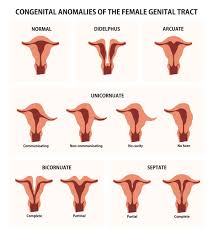
Congenital abnormalities of the female reproductive tract are developmental issues that form in the embryo. It can be in the vagina, cervix, uterus and fallopian tubes that occur while the child is growing in the womb. A few percentage of the female population has congenital abnormalities of the reproductive tract. These abnormalities can arise out of abnormal or missing genes, but those who don’t have genetic abnormalities can also have this condition. Unlike a developmental disorder, a congenital abnormality of reproductive tract is not likely to be obvious as soon as the child is born. It may go unnoticed even during puberty or after menstruation has begun, getting diagnosed only when they are pregnant or trying to conceive. Abnormalities of the reproductive tract may be accompanied by congenital disorders of the urinary tract, kidneys and spine.
[button title=”Talk with A Gynaecologist” link=”https://www.kjkhospital.com/contact-us/” target=”_blank” align=”” icon=”” icon_position=”” color=”yellow” font_color=”black” size=”4″ full_width=”” class=”” download=”” onclick=””]
Causes of female reproductive tract congenital abnormalities:
In order for a healthy baby to develop in the womb, a multitude of factors should fall in line. At the same time, a host of factors can interrupt it as well. Issues in development may be related to genetic abnormalities, use of certain drugs during pregnancy. Some of these anomalies can adversely affect the female reproductive system and contribute to pregnancy-related issues. Having a frank discussion with your doctor regarding your past medical and family history when you plan to conceive can help find out if you are suffering from any congenital abnormalities. It will certainly stave off further complications.
Types of female reproductive tract congenital abnormalities:
- a) Congenital abnormalities of the uterus:
- Septate uterus
- Bicornuate uterus
- Arcuate uterus
- Unicornuate
- Didelphys
- b) Congenital abnormalities of the vulva:
- Labial hypoplasia
- Labial hypertrophy
- c) Congenital abnormalities of the hymen:
- Imperforate hymen
- Microperforate hymen
- Septate hymen
- d) Congenital abnormalities of the vagina:
- Transverse vaginal septum
- Vertical or complete vaginal septum
- Vaginal agenesis
- e) Congenital abnormalities of the cervix:
- Cervical agenesis
- Cervical duplication
Symptoms associated with the condition:
Symptoms depend on the girl’s age and the severity of the condition. Signs apparent in infancy may include:
- Abnormal vaginal opening
- Genitals that are hard to identify as a girl or boy (ambiguous genitalia)
- Labia that are stuck together or unusual in size
- No openings in the genital area or a single rectal opening
- Swollen clitoris
- Inability to empty the bladder
As the girl reaches maturity, the symptoms may include:
- Breasts do not grow
- No menstruation (amenorrhea) by age 15 despite normal female development
- Monthly cramping or pain, without menstruation
- A lump in the lower abdomen, usually caused by blood or mucus that cannot drain appropriately
- Menstrual flow that occurs despite the use of a tampon
- Painful menstruation that worsens with time
- Menstrual overflow with tampon use (a sign of a second vagina)
- Pain with intercourse
- Repeated miscarriages or preterm births (maybe due to an abnormal uterus)
- Pain with intercourse.
Diagnosis of congenital abnormalities of the female reproductive tract:
Specialists in gynecology can detect some abnormalities on physical examination. Further diagnostic tests may include:
- Karyotyping (genetic testing)
- Testing of hormone levels
- Ultrasound or MRI of the pelvic area.
- Exam under anesthesia
Treatment for congenital abnormalities of the female reproductive tract:
Surgical options: Most of the congenital abnormalities of the reproductive tract are corrected via surgically. If there is a blockage of the vagina and/or uterus, an operative procedure is necessary to fix the problem. If the abnormality is identified at an early stage, which means, during childhood, the surgical procedure is delayed until the child is older and menstruation has begun (though there are some surgeries for reproductive tract disorders that are performed on children).
After assessing the area, intensity, symptoms or concerns about a successful pregnancy, if the doctor determines you need surgery, the following operative methods may be used.
Laparoscopy: Operative laparoscopy is a type of keyhole surgery that is performed in the abdominal (belly) area. It has advantages over open surgery, such as speedy recovery, reduced pain and no long scars. If you have a laparoscopy, it often means you don’t need to stay in hospital overnight. It is a minimally invasive procedure.
Hysteroscopy: Operative hysteroscopy is used to remove uterine septum.
Dilator: In the unlikely event, if a girl is born without vagina, options for creating a vagina for her are explored once she has gone through puberty. She may be advised to use a dilator as it is the simplest and effective treatment. This area where the vagina is supposed to be can be stretched and widened with this device. Through this non-operative route, it takes four to six months to create a new vagina.
Emotional support: This is fundamental for families of children diagnosed with abnormalities of the reproductive organs. It would be a good idea to seek the help of counseling and support groups as the girls get older.
For enquiries and online appointments, send a message to www.KJKHospital.com/contact








